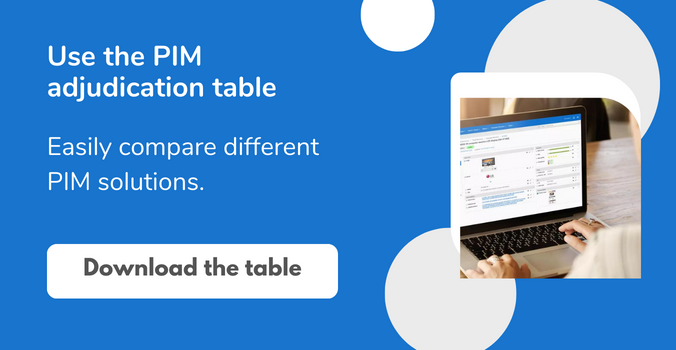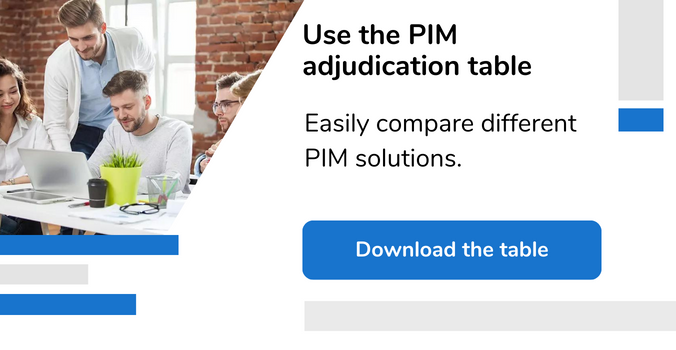Many businesses use PIM (Product Information Management) software to manage their product information. Among the main advantages1 of PIM software: reducing the risks of errors in product information (74%), enhancing the customer experience (61%), reducing the time to market (58%).
When a business decides to get equipped, they are faced with a long painstaking phase of comparing the different PIM options on the market.
Making a successful call for bids for the implementation of a PIM project requires the business to go further into the details of the features available in PIM options on the market (download a PIM call for bids template). They must also consider other essential criteria to guarantee the success of their project: quality and availability of support, autonomy of use and administration, training options, support throughout the project phases…
Discover what not to miss for an in-depth comparison of PIM (Product Information Management) software.
#PIM comparison: make an initial selection
Before going too far in your PIM comparison, the « cost » and « features » are extremely important elements to consider for the initial selection.
#Comparing features
To compare the features of different PIM systems, start by identifying the essential features of a modern and high performing PIM. You must also identify all the features that your teams will need to manage product information every day.
Once you have itemized all of theses features, you must list them in order of priority: « essential », « useful », « optional »... you should balance out each element. When analyzing each different solution, you can attribute a grade for each criterion and eliminate the PIM solutions which don't meet your minimum requirements. This ranking will allow you to identify the PIM option which best meets your needs.
#Module comparison
Print, Analytics, automated video generation… On the PIM market, the available modules are very diverse and cover a wide range of applications.
To compare the modules of different PIM systems, you need to identify those most likely to help your teams achieve their objectives (generating ROI, implementing a print communication strategy, producing advertising videos at scale…) and assess how they can be integrated. Some PIMs natively include modules, which means there are no additional integration costs and compatibility is guaranteed.
#Cost comparison
« Open-source PIM », « Proprietary PIM », « free version », « paying version »... On the PIM market, there is a range of economic formats. Comparing the costs of these PIMs can be very confusing for a business, in particular when comparing « open source » with « free options ».
To correctly evaluate the cost of a PIM, estimate the global cost while considering all the necessary elements for a successful PIM project: cost of the license, hosting and operating the solution, support, training, implementation and recurring costs…
#Evaluate the compatibility of PIM with your IS
The PIM solution you choose needs to integrate with the company's Information system (IS) and exchange with a variety of software (ERP, CRM, eCommerce platforms…). It is therefore important to assess the compatibility of each solution with your IS and to determine the workload (configurations, additional developments, support…) required to complete this integration.
#PIM comparison: taking it further

PIM projects are complex and involve a substantial investment in terms of finance and energy. These projects have a significant impact on the organization and the day to day lives of your teams: time required to appropriate the new software, changes in working methods, integration of new processes… for all these reasons it is essential to choose a reliable, experienced and receptive partner for your PIM solution.
#Research potential PIM partners
The partner in charge of implementing the PIM (whether it's the editor themselves or a third-party integrator) must be able to work simply and efficiently with your teams: language, timescale, communication methods, responsiveness, understanding company culture and concerns…
#Determine the roles
Before committing to a partner for a PIM solution, a business must have a clear and precise vision of each of the stakeholders involved in the success of the project. They must be able to identify them (editor, integrator, community…) and to coordinate them for a successful project implementation (configuration of the platform, integration, training provided to the different profiles…).

The business must also consider, right from the beginning, how the solution will work in production: identify the people in charge of support, hosting and operations, study the procedures (response times, availabilities, interactions with the editor, back-ups, procedures in case of downtime and/or breakdown…). This analysis is essential to ensure that the potential partners will be capable of responding to your availability constraints and performance requirements.
#Ensure that you have good support
To ensure the success of a PIM project, a professional team must support the business throughout the project. It is essential to choose a conscientious partner with solid customer references.
Among the most relevant criteria that you should analyze when choosing the right partner: the number of years of experience, customer references and industries, the variety of profiles composing the team… It is also advisable to ask to connect with some of the customers of a potential partner to get some feedback.
#Demand a POC (Proof Of Concept)
You probably wouldn't buy a car without testing it! It's the same thing for a software solution: it's important to be able to test the tool, to fully understand its ergonomics and how it works. For a PIM solution, you should test it with your product data as the demo cases are always adapted to each solution. You could check that the PIM works well with your data and make a true comparison of the chosen solutions. Insist that your provider carries out a POC (Proof Of Concept) which is a pre-configuration of the software with your own test data. The POC should then be made available to you in a demonstration environment to which you have full access. Creating a POC requires an effort from the service provider but must be demanded during the shortlist phase.
#And after you've made your choice?
With the right partner and the right methods, you have what you need to make a success of your project. Now find out how to implement them.
1Ventana Research. Building a Business Case for PIM. ventanaresearch.com.







